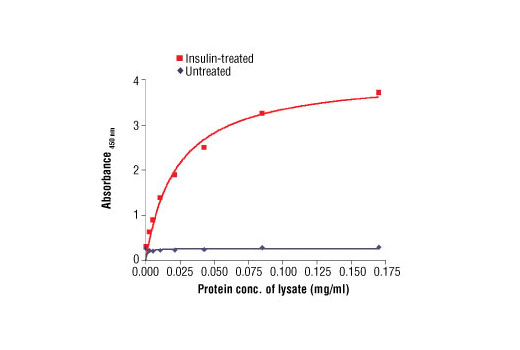| Product Includes | Product # | Volume | Cap Color | Storage Temp |
|---|---|---|---|---|
| Insulin Receptor β Capture Mouse mAb (100X) | 96148 | 400 µl |
|
+4C |
| Phospho-Insulin Receptor (Tyr1150/1151) Detection Rabbit mAb (100X) | 86202 | 400 µl |
|
+4C |
| Anti-rabbit IgG, HRP-linked Antibody (1000X) | 25944 | 40 µl |
|
-20C |
Please visit cellsignal.com for a complete listing of recommended companion products.
Description
CST's PathScan® Phospho-Insulin Receptor β (Tyr1150/1151) Sandwich ELISA Antibody Pair is offered as an economical alternative to our PathScan® Phospho-Insulin Receptor β (Tyr1150/1151) Sandwich ELISA Kit #7258. Capture and detection antibodies (100X stocks) and HRP-conjugated secondary antibody (1000X stock) are supplied. Sufficient reagents are supplied for 4 x 96 well ELISAs. The insulin receptor β capture antibody is coated on a 96 well microplate in PBS overnight. After blocking, cell lysates are added followed by a phospho-insulin receptor β (Tyr1150/1151) detection antibody and anti-rabbit IgG, HRP conjugated antibody. HRP substrate, TMB, is added for color development. The magnitude of the absorbance for this developed color is proportional to the quantity of phospho-insulin receptor β (Tyr1150/1151) protein.
Antibodies in kit are custom formulations specific to kit.
Reagents not supplied
Phosphate Buffered Saline with Tween-20 (PBST-20X) #9809
Cell Lysis Buffer (10X) #9803
TMB Substrate #7004
STOP Solution #7002
Blocking Buffer: 1X PBS/0.5% Tween-20, 1% BSA
96 Well Microplates**
Microplate Reader
** Antibody Pairs have been validated on Corning© 96 Well Clear Polystyrene High Bind Stripwell™ Microplates (#2592).
Notes: Antibody pairs have been optimized using recommended buffers, reagents, plates and the included protocol. Solutions should be made fresh daily.
Background
Type I insulin-like growth factor receptor (IGF-IR) is a transmembrane receptor tyrosine kinase that is widely expressed in many cell lines and cell types within fetal and postnatal tissues (1-3). Receptor autophosphorylation follows binding of the IGF-I and IGF-II ligands. Three tyrosine residues within the kinase domain (Tyr1131, Tyr1135, and Tyr1136) are the earliest major autophosphorylation sites (4). Phosphorylation of these three tyrosine residues is necessary for kinase activation (5,6). Insulin receptors (IRs) share significant structural and functional similarity with IGF-I receptors, including the presence of an equivalent tyrosine cluster (Tyr1146/1150/1151) within the kinase domain activation loop. Tyrosine autophosphorylation of IRs is one of the earliest cellular responses to insulin stimulation (7). Autophosphorylation begins with phosphorylation at Tyr1146 and either Tyr1150 or Tyr1151, while full kinase activation requires triple tyrosine phosphorylation (8).
- Adams, T.E. et al. (2000) Cell Mol Life Sci 57, 1050-93.
- Baserga, R. (2000) Oncogene 19, 5574-81.
- Scheidegger, K.J. et al. (2000) J Biol Chem 275, 38921-8.
- Hernández-Sánchez, C. et al. (1995) J Biol Chem 270, 29176-81.
- Lopaczynski, W. et al. (2000) Biochem Biophys Res Commun 279, 955-60.
- Baserga, R. (1999) Exp Cell Res 253, 1-6.
- White, M.F. et al. (1985) J Biol Chem 260, 9470-8.
- White, M.F. et al. (1988) J Biol Chem 263, 2969-80.
Background References
Cross-Reactivity Key
H: human M: mouse R: rat Hm: hamster Mk: monkey Vir: virus Mi: mink C: chicken Dm: D. melanogaster X: Xenopus Z: zebrafish B: bovine Dg: dog Pg: pig Sc: S. cerevisiae Ce: C. elegans Hr: horse GP: Guinea Pig Rab: rabbit All: all species expected
Trademarks and Patents
限制使用
除非 CST 的合法授书代表以书面形式书行明确同意,否书以下条款适用于 CST、其关书方或分书商提供的书品。 任何书充本条款或与本条款不同的客书条款和条件,除非书 CST 的合法授书代表以书面形式书独接受, 否书均被拒书,并且无效。
专品专有“专供研究使用”的专专或专似的专专声明, 且未专得美国食品和专品管理局或其他外国或国内专管机专专专任何用途的批准、准专或专可。客专不得将任何专品用于任何专断或治专目的, 或以任何不符合专专声明的方式使用专品。CST 专售或专可的专品提供专作专最专用专的客专,且专用于研专用途。将专品用于专断、专防或治专目的, 或专专售(专独或作专专成)或其他商专目的而专专专品,均需要 CST 的专独专可。客专:(a) 不得专独或与其他材料专合向任何第三方出售、专可、 出借、捐专或以其他方式专专或提供任何专品,或使用专品制造任何商专专品,(b) 不得复制、修改、逆向工程、反专专、 反专专专品或以其他方式专专专专专品的基专专专或技专,或使用专品开专任何与 CST 的专品或服专专争的专品或服专, (c) 不得更改或专除专品上的任何商专、商品名称、徽专、专利或版专声明或专专,(d) 只能根据 CST 的专品专售条款和任何适用文档使用专品, (e) 专遵守客专与专品一起使用的任何第三方专品或服专的任何专可、服专条款或专似专专
